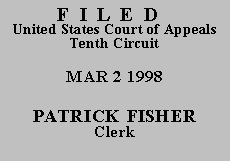

| UNITED STATES OF AMERICA, | No. 97-2178
(D.C. No. 95-CR-23-LH) |
On December 19, 1994, undercover agent Michael Pelligrini of the Drug Enforcement Administration Metropolitan Task Force met with Johnson at Johnson's home to negotiate the purchase of crack cocaine. The actual transaction took place at a nearby fast-food restaurant. Agent Pelligrini handed approximately $1,200 to Johnson; Johnson then pointed to the location of a brown paper bag. It was later determined that the bag contained 27 net grams of crack cocaine.
Agent Pelligrini subsequently obtained a search warrant for Johnson's home which was executed on December 22 by the DEA and the Bernalillo County Sheriff's Department. During a search of the residence, the officers discovered 18.33 net grams of crack cocaine, scales, $1,021 in cash, and written notes and instructions related to narcotics sales. The officers also found a 12 gauge sawed-off shotgun, fully-loaded with the safety disengaged, and a .380 caliber semi-automatic pistol, fully-loaded with a round of ammunition chambered. Both weapons were in the living room, and Johnson's fingerprints were found on the sawed-off shotgun. During the search, Johnson and a companion returned home. Both men were detained. A search of their vehicle revealed a 9mm Taurus semi-automatic pistol also with a round of ammunition chambered.
At the sentencing hearing following his guilty plea, Johnson objected to the proposed two-level increase under § 2D1.1(b)(1). In response, the government submitted an affidavit prepared by Agent Pelligrini detailing his investigation and listing the items found in Johnson's residence. Adopting the factual findings in the pre-sentence report, the district court overruled Johnson's objections and enhanced his sentence. We review the district court's factual determinations for clear error. See United States v. Robertson, 45 F.3d 1423, 1449 (10th Cir. 1995)
To sustain an enhancement under § 2D1.1(b)(1), the government must prove by a preponderance of the evidence "that a temporal and spatial relation existed between the weapon, the drug trafficking activity, and the defendant." United States v. Roederer, 11 F.3d 973, 982 (10th Cir. 1993) (quoting United States v. Eastland, 989 F.2d 760, 770 (5th Cir. 1993)). "Generally, the government must provide evidence that the weapon was found in the same location where drugs or drug paraphernalia are stored or where part of the transaction occurred." Id. at 983 (quoting United States v. Hooten, 942 F.2d 878, 882 (5th Cir. 1991)). If the government meets its burden, the defendant must show that it is "clearly improbable" that the weapon was related to the offense. See Robertson, 45 F.3d at 1449; see also U.S.S.G. § 2D1.1, comment. (n.3) ("The adjustment should be applied if the weapon was present, unless it is clearly improbable that the weapon was connected with the offense.").
The evidence presented by the government indicated that loaded weapons, drugs, a large quantity of money and drug paraphernalia were found in Johnson's home. One of the firearms had Johnson's fingerprints on it. Additionally, the first meeting between Agent Pelligrini and Johnson took place at Johnson's home. We therefore find no error in the district court's conclusion that the government met its burden of showing the relationship between the weapon, the offense and the defendant by a preponderance of the evidence.
The defendant argues that the government presented no evidence that he had possession of the guns, given that there were other occupants of the residence. He also contends that because Agent Pelligrini's affidavit failed to state sufficient information as to the spatial proximity of the weapons to the drugs, the district court's sentencing decision was erroneous. We are unpersuaded that these arguments are sufficient to establish that it was "clearly improbable" that the weapons were connected to drug trafficking.
Based on the evidence, the district court judge was not clearly erroneous in enhancing Johnson's sentence. AFFIRMED.
The mandate shall issue forthwith.
ENTERED FOR THE COURT
Carlos F. Lucero
Circuit Judge
*.The case is unanimously ordered submitted without oral argument pursuant to Fed. R. App. P. 34(a) and 10th Cir. R. 34.1.9. This order and judgment is not binding precedent, except under the doctrines of law of the case, res judicata, and collateral estoppel. The court generally disfavors the citation of orders and judgments; nevertheless, an order and judgment may be cited under the terms and conditions of 10th Cir. R. 36.3.